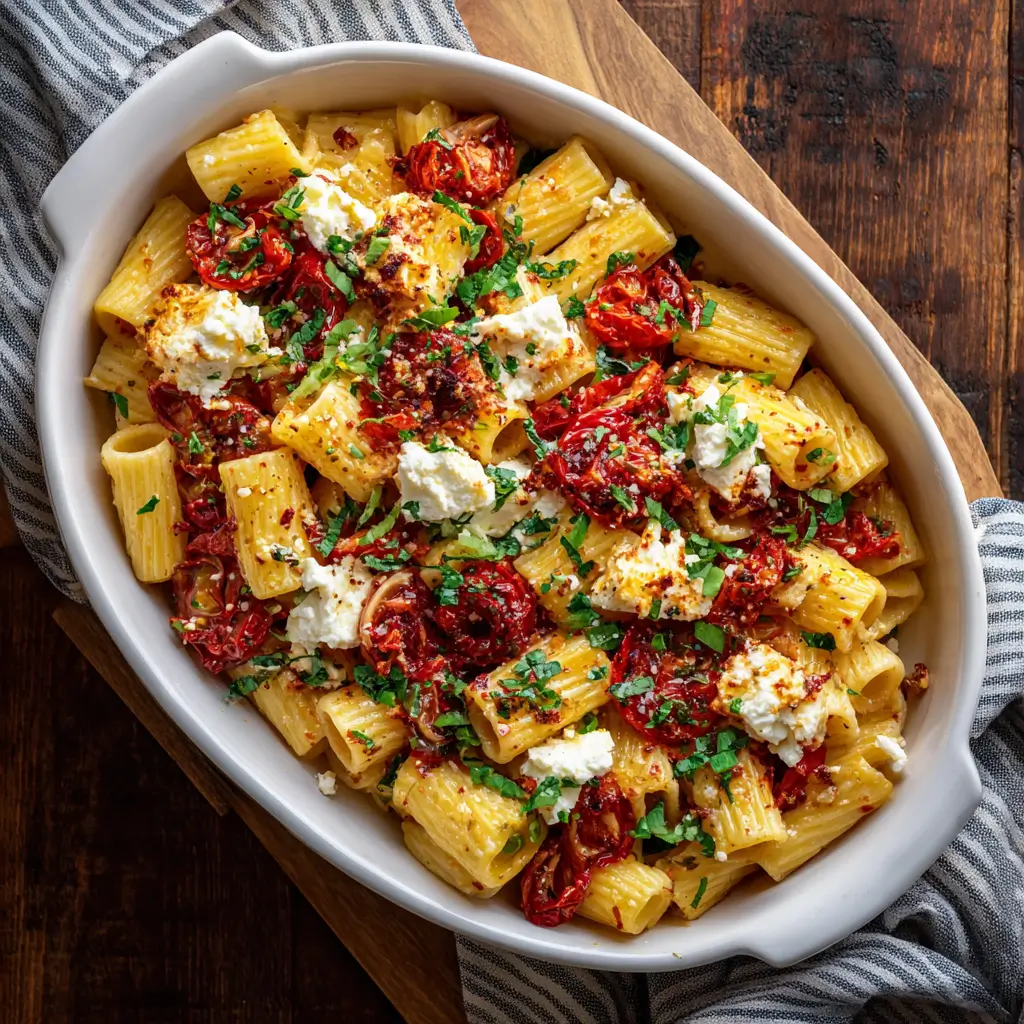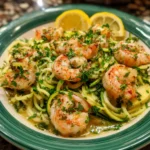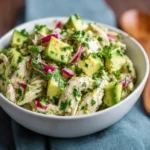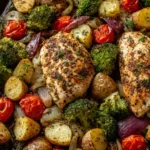Introduction
Baked Feta Pasta has taken the culinary world by storm, captivating food lovers with its creamy texture, vibrant colors, and effortless preparation. Originating as a viral sensation on social media platforms like TikTok in early 2021, this dish quickly became a global favorite due to its simplicity, minimal ingredient list, and rich flavor profile. At its heart, Baked Feta Pasta is a comforting yet elegant one-pan meal that combines the tangy richness of feta cheese with juicy cherry tomatoes, aromatic garlic, and fragrant herbs—all baked together and tossed with perfectly cooked pasta. It’s no wonder that home cooks and professional chefs alike have embraced this modern classic as a go-to weeknight dinner or an impressive dish for entertaining guests.
What sets Baked Feta Pasta apart from other pasta dishes is not just its aesthetic appeal but also the way it celebrates Mediterranean flavors using accessible ingredients. The magic happens in the oven: as the feta softens and begins to melt, it blends with the roasting tomatoes and garlic to create a luscious, velvety sauce that clings beautifully to the pasta. Unlike traditional cream-based sauces, this recipe relies on natural ingredients to achieve its luxurious consistency, making it both indulgent and surprisingly wholesome. Whether you’re a beginner in the kitchen or an experienced cook looking for inspiration, Baked Feta Pasta offers a satisfying culinary experience that’s both fun to make and delightful to eat.
The History
The story of Baked Feta Pasta begins not in ancient Greece or Italy, but rather in the digital kitchens of modern-day Finland. The dish was first created and shared online by Finnish food blogger Jenni Häyrinen in 2019 under the name “Paahtofetajuustoja,” which translates to “baked feta cheese.” Initially posted on her blog Pahat Pojat, the recipe featured halloumi instead of feta, but she later adapted it after realizing that feta worked better in the context of a creamy baked pasta dish. What started as a simple family recipe soon gained traction across Nordic countries before going truly viral in early 2021 when TikTok user @pastaships (also known as Laura) recreated and popularized it under the now-iconic name “Baked Feta Pasta.”
Within weeks, #bakedfetapasta exploded on TikTok, amassing over a billion views and inspiring countless recreations, remixes, and parodies. Users around the world filmed themselves slicing tomatoes, placing a block of feta in the center, drizzling olive oil, and baking the mixture before tossing it with pasta—often set to catchy music or dramatic sound effects. The trend transcended borders, languages, and cultures, becoming one of the most shared food trends in recent history. Grocery stores reported spikes in feta cheese sales, and restaurants began adding variations of the dish to their menus almost overnight.
While the concept of combining baked cheese with tomatoes and pasta isn’t entirely new—similar ideas appear in Greek and Italian cuisines—the genius of this version lies in its minimalism and visual storytelling. Its success reflects broader shifts in how people discover and engage with food today: through short-form video, community participation, and the joy of replicating something deliciously simple. Though trends come and go, Baked Feta Pasta has earned its place in contemporary culinary culture, proving that sometimes the most impactful dishes are born not in Michelin-starred kitchens, but on smartphones in cozy home ovens.
Ingredients Breakdown
The beauty of Baked Feta Pasta lies in its simplicity and the harmony between a few high-quality ingredients. Each component plays a vital role in building the dish’s signature flavor and texture. Let’s take a closer look at what goes into this beloved recipe and why each ingredient matters:
- Feta Cheese: Traditionally made from sheep’s milk or a blend of sheep and goat milk, feta brings a salty, tangy punch that intensifies when baked. When heated, it softens and partially melts, releasing its creamy interior while maintaining structure. Opt for a block of authentic Greek feta packed in brine for the best flavor and texture—avoid pre-crumbled versions, which often contain anti-caking agents and dry out faster.
- Cherry Tomatoes: These small, sweet tomatoes burst during baking, releasing juices that form the base of the sauce. Their natural acidity balances the saltiness of the feta, while their color adds vibrancy to the final dish. Use ripe, firm tomatoes for optimal results; heirloom varieties can add complexity, but standard red cherry or grape tomatoes work perfectly.
- Garlic: Fresh garlic cloves add depth and aroma. As they roast, their sharpness mellows into a sweet, nutty flavor that infuses the entire dish. Don’t skimp—several whole cloves ensure bold garlicky notes without overwhelming heat.
- Olive Oil: A good extra virgin olive oil acts as both a cooking medium and a flavor enhancer. It helps the tomatoes caramelize, prevents sticking, and carries the fat-soluble flavors of herbs and spices throughout the dish. Choose a fruity, peppery variety for maximum impact.
- Red Pepper Flakes: Just a pinch adds a gentle warmth that complements the richness of the cheese and sweetness of the tomatoes. Adjust according to your spice tolerance—some prefer a fiery kick, while others omit it entirely.
- Salt and Black Pepper: Essential seasonings that elevate all components. While feta is already salty, a touch more sea salt enhances overall flavor, especially if using low-sodium feta. Freshly ground black pepper contributes earthy warmth.
- Pasta: Short, tubular shapes like penne, rigatoni, or fusilli work best because they hold onto the creamy sauce. Barilla or De Cecco brands are reliable choices. For gluten-free diets, brown rice or chickpea-based pastas perform well, though cooking times may vary.
- Fresh Basil: Added at the end, fresh basil provides a bright, herbal finish that lifts the richness of the dish. Its aromatic oils are delicate, so tearing rather than chopping preserves flavor. Alternatively, parsley or oregano can be used for different herbal profiles.
- Parmesan Cheese (optional): Though not part of the original recipe, many add grated Parmesan or Pecorino Romano for extra umami and creaminess. This creates a hybrid Mediterranean-Italian twist and deepens the savory notes.
- Pasta Water: Often overlooked, starchy pasta water is key to emulsifying the sauce. Reserving about ½ to 1 cup before draining allows you to loosen the sauce and help it coat every strand evenly.
Step-by-Step Recipe
- Preheat the Oven: Begin by preheating your oven to 400°F (200°C). This ensures even roasting and proper caramelization of the tomatoes.
- Prepare the Baking Dish: Select a large oven-safe baking dish or cast-iron skillet that can comfortably hold all ingredients. Arrange 2 cups of halved cherry tomatoes in an even layer across the bottom of the dish.
- Add Aromatics: Nestle 4–6 peeled garlic cloves among the tomatoes. Sprinkle them with ½ teaspoon of red pepper flakes (adjust to taste), ½ teaspoon of freshly ground black pepper, and ½ teaspoon of sea salt (less if your feta is very salty).
- Place the Feta: Center a 7-ounce (200g) block of feta cheese in the middle of the tomato mixture. Drizzle generously with 3–4 tablespoons of extra virgin olive oil, ensuring the top and sides of the feta are well-coated.
- Bake Until Golden: Transfer the dish to the preheated oven and bake for 30–40 minutes. The tomatoes should soften, blister, and release their juices, while the feta puffs slightly and develops golden edges. The garlic will become tender and golden brown.
- Cook the Pasta: While the feta and tomatoes are baking, bring a large pot of salted water to a boil. Add 12 ounces (340g) of pasta—penne, rigatoni, or another short shape—and cook according to package instructions until al dente. Reserve 1 cup of pasta water before draining.
- Mash and Mix: Once the baking is complete, use a fork to gently mash the roasted garlic and softened tomatoes into the melted feta. Stir thoroughly until a thick, creamy sauce forms. If needed, stir in a splash of reserved pasta water to loosen the mixture.
- Combine with Pasta: Add the drained pasta directly into the baking dish (or transfer everything to a large mixing bowl). Toss vigorously to coat every piece of pasta with the warm, cheesy tomato sauce.
- Finish with Fresh Herbs: Tear fresh basil leaves by hand and scatter them over the top. Optionally, sprinkle with grated Parmesan cheese for added depth.
- Serve Immediately: Serve hot, ideally straight from the pan, garnished with additional basil, a drizzle of olive oil, or cracked black pepper. Pair with crusty bread or a crisp green salad for a complete meal.
Tips
- Use Room-Temperature Feta: Remove the feta from the fridge 15–20 minutes before baking to allow it to warm up slightly. This promotes more even melting and integration into the sauce.
- Don’t Overcrowd the Pan: Ensure there’s enough space for air circulation around the tomatoes and feta. If the pan is too small, moisture won’t evaporate properly, leading to steaming instead of roasting.
- Choose the Right Pasta: Durable, ridged pastas like rigatoni or campanelle hold sauce exceptionally well. Avoid thin strands like spaghetti unless you want a lighter texture.
- Reserve Plenty of Pasta Water: Starchy water is essential for adjusting the consistency of your sauce. Start with ½ cup and add more as needed during mixing.
- Enhance Flavor with Lemon Zest: A little lemon zest added at the end brightens the dish and cuts through the richness—just avoid adding juice too early, as acidity can curdle dairy.
- Roast Longer for Deeper Flavor: For a more concentrated, caramelized taste, extend baking time by 5–10 minutes, watching closely to prevent burning.
- Stir Gently After Baking: Use a silicone spatula or wooden spoon to blend the feta and tomatoes without scratching your pan, especially if using nonstick or enameled surfaces.
- Double the Batch: This dish reheats well and freezes nicely. Make extra for easy lunches or freezer meals—store in airtight containers for up to 3 months.
- Add Protein Midway: If including chicken, shrimp, or plant-based proteins, sauté separately and fold in after combining pasta and sauce to maintain texture.
- Taste Before Adding Salt: Since feta varies in salt content, always taste the sauce before seasoning further to avoid oversalting.
Variations and Customizations
Baked Feta Pasta is incredibly versatile, lending itself to endless adaptations based on dietary preferences, seasonal availability, or creative flair. Here are some popular and innovative twists to personalize your dish:
- Creamy Version: Stir in ¼ to ½ cup of heavy cream, mascarpone, or crème fraîche after baking for a richer, silkier sauce reminiscent of Alfredo.
- Vegan Adaptation: Replace feta with vegan feta (available in stores or homemade from tofu and nutritional yeast), use olive oil, and choose plant-based pasta. Add capers for brininess and miso paste for umami.
- Protein-Packed: Top with grilled chicken breast, shrimp, Italian sausage, or chickpeas for a heartier meal. You can also stir in canned white beans or lentils for fiber and plant protein.
- Vegetable Boost: Add bell peppers, zucchini slices, spinach, artichoke hearts, or roasted eggplant for extra nutrition and texture. Roast harder veggies alongside the tomatoes; add greens at the end.
- Pesto Swirl: Mix in 2–3 tablespoons of basil pesto after combining the pasta for a herby, nutty dimension.
- Dairy-Free Cheese Option: Try baked halloumi as a firmer alternative, though it won’t melt the same way. Or experiment with smoked mozzarella for a milder, stretchy effect.
- Spicy Kick: Increase red pepper flakes or add sliced jalapeños, Calabrian chili paste, or harissa for intense heat.
- Mediterranean Twist: Incorporate kalamata olives, sun-dried tomatoes, roasted red peppers, and fresh oregano for a Greek-inspired platter.
- Seafood Style: Fold in seared scallops, flaked salmon, or mussels after baking for an elegant seafood variation.
- One-Pan Wonder: Cook the pasta directly in the baking dish by covering with broth and water before roasting (though texture may differ slightly from boiled pasta).
- Herb Variations: Swap basil for mint, dill, parsley, or chives depending on the flavor profile you desire—mint pairs wonderfully with lamb, while dill complements fish.
- Grain Alternatives: Serve over quinoa, farro, couscous, or cauliflower rice for a lower-carb or whole-grain option.
Health Considerations and Nutritional Value
While Baked Feta Pasta is undeniably delicious, understanding its nutritional composition can help you enjoy it mindfully as part of a balanced diet. On average, a single serving (about 1.5 cups) contains approximately:
- Calories: 450–550 kcal
- Total Fat: 20–28g (mostly from olive oil and feta)
- Saturated Fat: 7–10g
- Cholesterol: 30–40mg
- Sodium: 600–900mg (highly dependent on feta brand and added salt)
- Carbohydrates: 50–60g
- Dietary Fiber: 3–5g
- Sugars: 5–7g (naturally occurring from tomatoes)
- Protein: 12–16g
Positive Aspects:
The dish includes several nutrient-dense ingredients. Cherry tomatoes are rich in antioxidants like lycopene and vitamin C, which support heart health and immunity. Olive oil provides heart-healthy monounsaturated fats and anti-inflammatory compounds. Garlic contains allicin, known for immune-boosting and cardiovascular benefits. Whole grain or legume-based pastas can increase fiber and protein content significantly.
Considerations:
Feta cheese, while flavorful, is relatively high in sodium and saturated fat. Those managing blood pressure or cholesterol levels should consume it in moderation. Using reduced-fat feta or decreasing the amount used can help mitigate this. Additionally, portion control is important—serving sizes can easily balloon due to the creamy, addictive nature of the sauce.
Healthy Modifications:
To make a lighter version: reduce olive oil to 2 tablespoons, use whole wheat or lentil pasta, increase vegetables (e.g., double the tomatoes or add spinach), and skip optional Parmesan. For lactose-sensitive individuals, aged cheeses like feta are generally well-tolerated, but lactose-free alternatives are available.
Overall, Baked Feta Pasta can be part of a nutritious diet when balanced with lean proteins, leafy greens, and mindful portioning. It’s a prime example of how comfort food and wellness can coexist with thoughtful tweaks.
Ingredients
- 2 cups cherry tomatoes, halved
- 1 (7 oz / 200g) block of feta cheese, preferably Greek brined feta
- 4–6 garlic cloves, peeled
- 3–4 tablespoons extra virgin olive oil
- ½ teaspoon red pepper flakes (adjust to taste)
- ½ teaspoon freshly ground black pepper
- ½ teaspoon sea salt (optional, depending on feta saltiness)
- 12 oz (340g) dried pasta (penne, rigatoni, or fusilli recommended)
- 1 cup reserved pasta water
- ½ cup fresh basil leaves, torn
- ¼ cup grated Parmesan cheese (optional)
Directions
- Preheat oven to 400°F (200°C).
- In a large oven-safe baking dish or skillet, arrange halved cherry tomatoes in a single layer.
- Add peeled garlic cloves, sprinkle with red pepper flakes, black pepper, and salt.
- Place the block of feta in the center and drizzle generously with olive oil.
- Bake for 30–40 minutes, until tomatoes are blistered and feta is golden on top.
- While baking, cook pasta in salted boiling water until al dente. Reserve 1 cup of pasta water, then drain.
- Remove baking dish from oven and use a fork to mash the roasted tomatoes, garlic, and feta into a creamy sauce.
- Add drained pasta to the dish and toss thoroughly, adding reserved pasta water as needed to reach desired consistency.
- Stir in torn basil and optional Parmesan cheese.
- Serve immediately, garnished with extra basil, cracked pepper, or a drizzle of olive oil.
FAQ
Can I make Baked Feta Pasta ahead of time?
Yes, you can prepare the tomato-feta mixture in advance and refrigerate it unbaked for up to 24 hours. Bake just before serving. Leftovers reheat well in the microwave or on the stovetop with a splash of water or broth.
Why didn’t my feta melt?
Feta doesn’t fully melt like mozzarella due to its high acid content and firm texture. However, it should soften significantly and blend into a creamy consistency when mashed with the roasted tomatoes and pasta water.
Is Baked Feta Pasta gluten-free?
Not inherently, but it can easily be made gluten-free by substituting with certified gluten-free pasta such as brown rice, corn, or chickpea-based varieties.
Can I freeze this dish?
Yes, Baked Feta Pasta freezes well for up to 3 months. Store in an airtight container and thaw overnight in the fridge before reheating gently on the stove with a bit of liquid to refresh the sauce.
What can I substitute for feta?
Halloumi, ricotta salata, or vegan feta are closest in texture and saltiness. For creaminess, consider baked goat cheese or even a mild blue cheese for a bolder twist.
Can I cook the pasta in the baking dish?
Some recipes suggest adding uncooked pasta directly to the dish with extra liquid (broth or water) and baking longer. Results vary—this method may yield softer pasta and require careful monitoring to avoid drying out.
How do I prevent the dish from being too oily?
Use only 3 tablespoons of olive oil and blot excess oil with a paper towel after baking if necessary. You can also balance richness with acidic elements like lemon juice or balsamic glaze.
Can I add meat?
Absolutely! Cooked and sliced chicken, Italian sausage, pancetta, or shrimp pair beautifully. Sauté separately and mix in at the end to preserve texture.
Is this dish vegetarian?
Yes, the base recipe is vegetarian. To keep it vegan, replace feta with a plant-based alternative and confirm pasta is egg-free.
Why is my sauce too thick or too thin?
Too thick? Add more reserved pasta water, 1–2 tablespoons at a time. Too thin? Continue tossing over low heat to evaporate excess moisture, or add a sprinkle of cheese to thicken.
Summary
Baked Feta Pasta is a modern culinary phenomenon that combines minimal effort with maximum flavor, featuring roasted cherry tomatoes, garlic, and a block of feta transformed into a creamy, dreamy sauce perfect for tossing with pasta. Simple, shareable, and endlessly customizable, it’s a must-try dish that continues to inspire home cooks worldwide.










